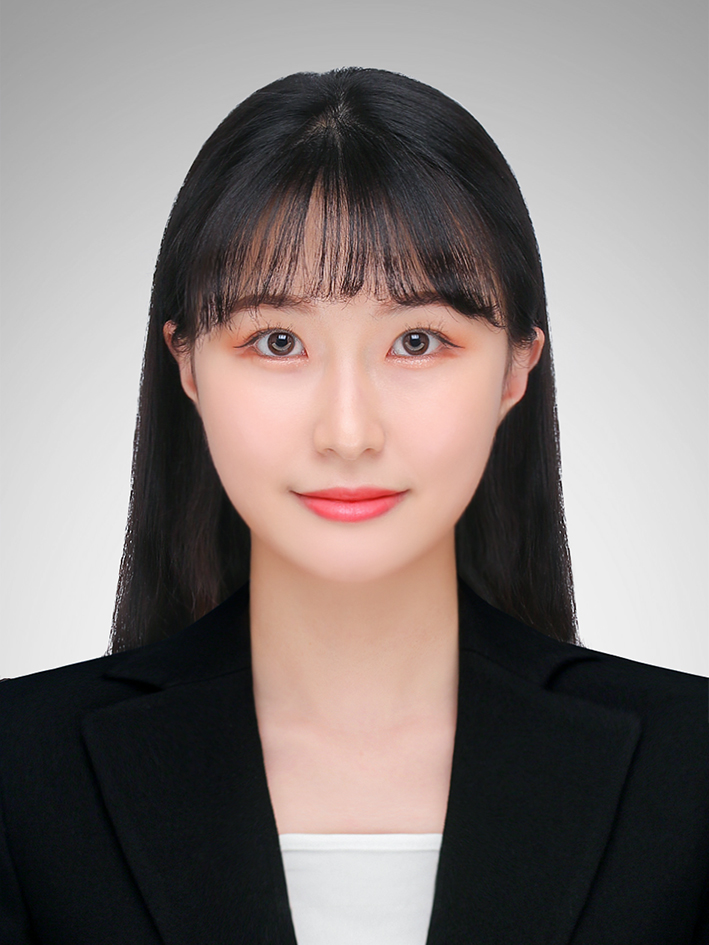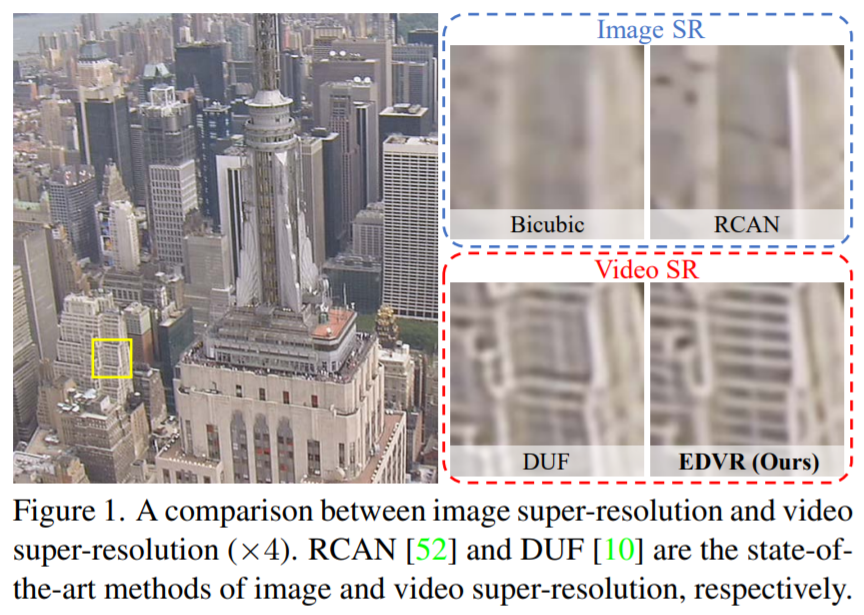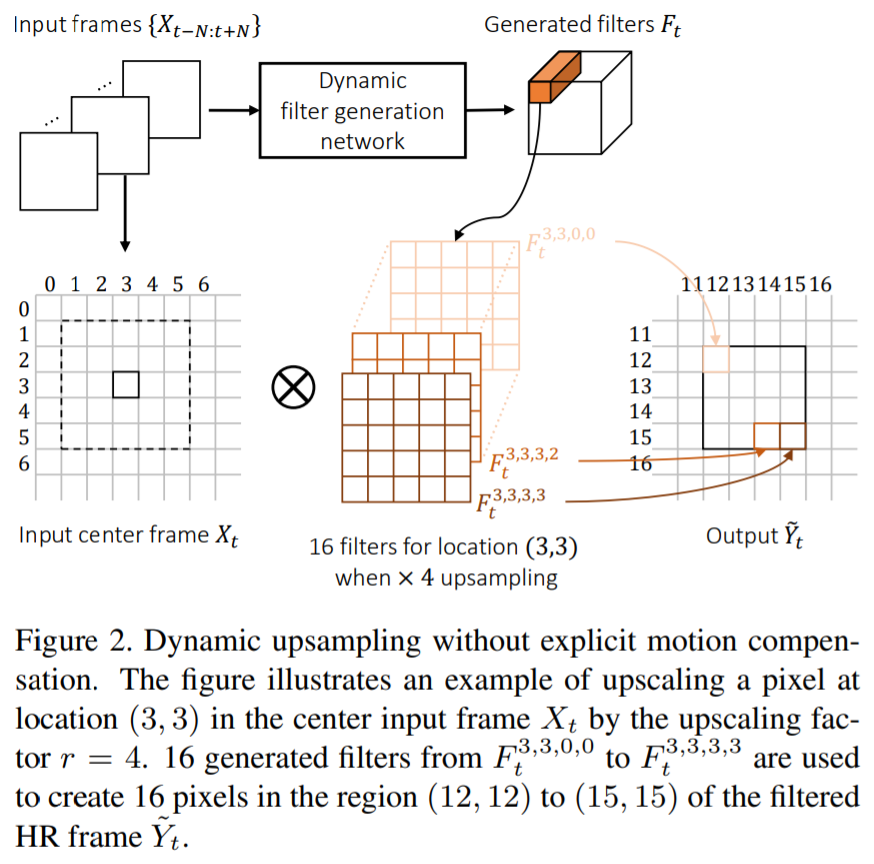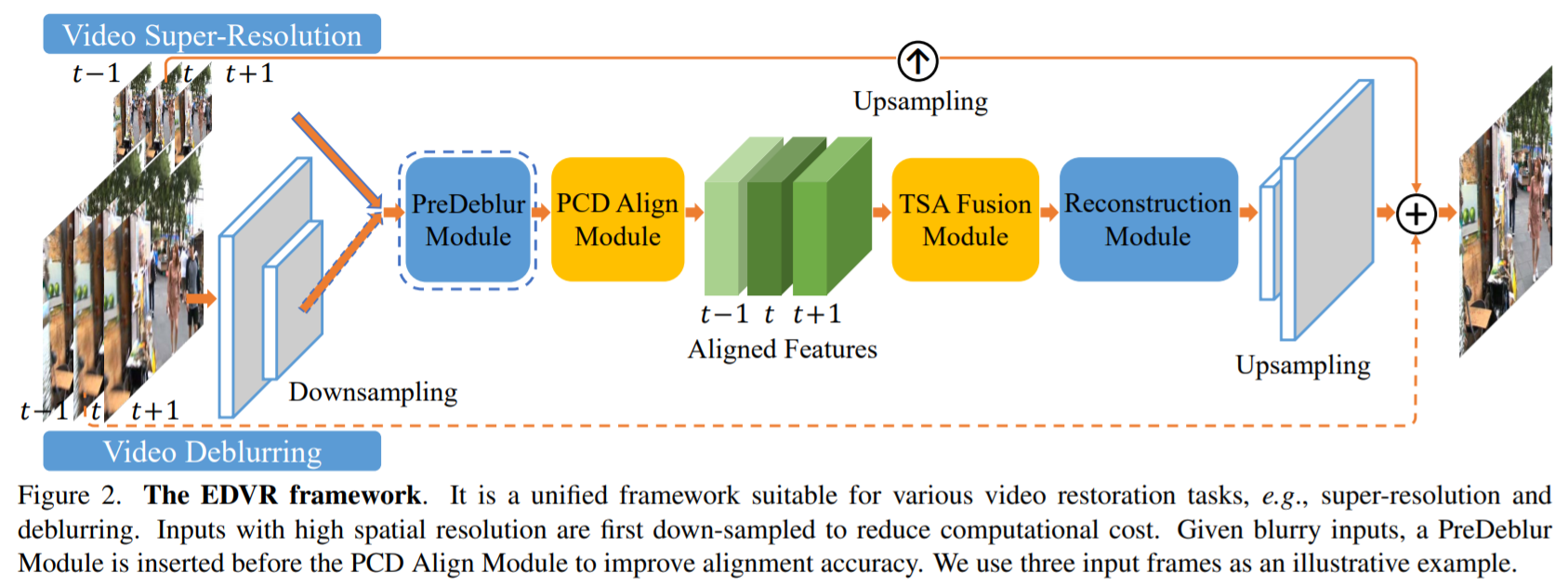[Paper Review] Edvr: Video restoration with enhanced deformable convolutional networks
Edvr: Video restoration with enhanced deformable convolutional networks
Wang, Xintao, et al. “Edvr: Video restoration with enhanced deformable convolutional networks.” Proceedings of the IEEE Conference on Computer Vision and Pattern Recognition Workshops. 2019.
Abstract
- NTIRE19 challenge에서 공개된 새로운 benchmark REDS
1) large motions이 주어진 muliple frames을 어떻게 alignment 하는 방법
2) 다양한 motion과 blur를 가진 frames을 효과적으로 융합시키는 방법
- 새로운 Video Restoration framework인 Enhanced Deformable convolutions(EDVR)을 제안
위의 challenges(REDS)를 잘 다루는 framework
1) large motions을 잘 다루기 위한 Pyramid, Cascading and Deformable alignment(PCD) module 고안
deformable convolutions을 사용하여 feature level에서 frame alginment 수행 (coarse-to-fine manner)
2) Temporal and Spatial Attention(TSA) module 제안
temporally and spatially 모두 attention이 적용되면서 다음 restoration에서 중요한 features를 강조함
-
The NTIRE19 video restoration and enhancement challenges에서 4개의 tracks 모두 1위 차지
-
video super-resolution과 video deblurring에서 SOTA 달성
Introduction
-
REDS dataset : 기존에 존재하던 datasets과 비교했을 때, 크고 복잡한 motions을 포함 (더 현실적이고 challenging)
-
초기 video SR은 image SR의 단순한 확장으로 다루어짐
문제점 : 이웃 frames 사이의 temporal 정보를 제대로 활용할 수 없음
- 최근 VSR 연구는 위의 문제점을 해결하기 위해 더 정교한 pipelines 사용
feature extraction -> alignment -> fusion -> reconstruction
- video가 occlusion, large motion, severe blurring을 포함하고 있을 때, alignment와 fusion module이 중요한 역할을 함
1) align and establish accurate correspondences among multiple frames
2) effectively fuse the aligned features for reconstruction
- Alignment
1) Optical flow : 기존의 많은 방식들은 optical flow를 사용하여 explicit alignment를 수행
2) dynamic filtering or deformable convolution : dynamic filtering or deformable convolution을 사용하여 implicit motion compensation 수행
dynamic filtering
TDAN
REDS는 기존의 alignmnet algorithms으로 다루기 challengeing한 dataset
large motions의 경우, single scale에서 motion compensation을 수행하는 것은 어려움 (explicitly or implicitly)
- Fusion
기존의 fusion 방식은 모든 frames에서 convolution을 사용하여 early fusion을 사용하거나, recurrent networks를 사용하여 점진적으로 multiple frames을 융합시킴
각 frame들이 얼마나 중요한 정보를 담고 있는지를 고려하지 않음 (모든 frames은 이미지 복원에 도움이 되는 정보를 각자 다르게 가지고 있음)
- Our Solution : EDVR
1) an alignment module known as Pyramid, Cascading and Deformable convolutions (PCD)
feature level에서 reference frame과 인접 frame 사이 alignment를 맞추기 위해 deformable convolutions을 사용 (TDAN에서 영감을 얻음)
large and complex motions을 다루기 위해, coarse-to-fine 방식으로 alignment를 수행한다는 점이 TDAN과 다름
Pyramid 구조 사용
first align feature in lower scales : coarse -> aligned features to higher scales : fine (정확한 motion compensation을 가능하게 함)
pyramidal alignmnet 연산을 수행한 후에, 추가적인 deformable convolution을 계단식으로 배치하여 alignmnet의 견고성을 높임
2) a fusion module known as Temporal and Spatial Attention (TSA)
multiple aligned features 사이 정보를 결합시키는 것을 돕는 module
Temporal attention : 각 frame의 visual informativeness를 더 잘 고려하기 위해, reference frame features와 모든 인접 frame features 사이의 element-wise correlation을 계산
Correlation coefficients : 각 위치에서의 각 인접 feature의 weight를 측정하여, 이미지를 복원하는데 얼마나 정보력을 갖고 있는지를 나타냄
Spatial attention : temporal attention fusion을 한 후, 더 효과적으로 cross-channel과 spatial 정보를 이용하기 위해 각 채널의 각 위치에 가중치를 할당하기 위해 spatial attentaion을 적용
Methodology
- 3.1 Overview
input : 2N+1 low-resolution frames -> output : high-resolution reference frame
1) 각 인접 frames은 PCD alignment module에 의해 feature level에서 reference frame에 alignmnent 됨
2) TSA module에서 다른 frames의 image 정보가 융합됨
3) 융합된 features는 reconstruction module로 들어감 (cascade of residual blocks)
다른 SISR module로 쉽게 대체 가능함
4) network의 끝 단에서 spatial size를 키우기 위해 upsampling 연산 수행
5) 최종적으로, 예측된 image residual을 upsampled image에 더하여 high-resolution frame을 얻음
Video deblurring과 같은 high-resolution inputs을 갖는 task에도 적용하기 위해, input frames을 처음에 strided convolution으로 down-sampling 시킴
대부분의 연산이 low-resolution에서 수행되기 때문에 계산 비용이 많이 절약됨
A PreDeblur module : alignment module을 수행하기 전, blurry inputs을 pre-processing 하고 alignmnet 정확도를 향상시키기 위해 사용
single EDVR model은 SOTA 성능을 달성했음에도 불구하고, NTIRE19 competition에서 성능을 더 끌어올리기 위해 two-stage strategy를 채택함
Cascaded network로 심각한 motion blur를 제거함 (preceding model에서는 다룰 수 없음)
- 3.2 Alignment with Pyramid, Cascading and Deformable Convolution
alignment를 위해 the modulated deformable module 사용
optical-flow based methods와 다르게 각 frame의 features에 적용됨
alignment에서 complex motions과 large parallax 문제를 해결하기 위해, PCD module 제안 (based on well established principles in optical flow??)
pyramidal processing and cascading refinement
pyramid level 별로 stride가 2인 convolution으로 down-sampling 수행
l-th level에서의 offsets과 alignment features가 2배 upsampling(bilinear interpolation)한 l+1-th level의 offsets과 aligned features와 함께 예측됨
- 3.3 Fusion with Temporal and Spatial Attention
fusion에서 frame 간 temporal 관계와 frame 내 spatial 관계가 중요한 이유
1) 다른 인접 frames은 동일하게 informative하지 않음 (occlusion, blurry regions and parallax problems)
2) preceding alignment stage에서 발생하는 misalignment와 unalignment는 다음 reconstruction 성능에 부정적인 영향을 끼침
=> 효과적이고 효율적인 fusion을 위해 pixel-level에서 인접 frames을 동적으로 합치는 것이 필수적임
TSA fusion module : 각 frame에서 pixel-level로 weight를 합치는 module
Temporal attention : embedding space에서 frame 사이 유사도를 계산
reference frame과 비슷할수록 더 강조시킴
Spatial attention : 융합된 features에서 계산됨
receptive field를 늘리기 위해 pyramid 구조 사용
- 3.4 Two-Stage Restoration
1) preceding model에서 다룰 수 없는 심각한 motion blur를 효율적으로 제거함
2) output frames 사이의 inconsistency를 완화시킴











Leave a comment